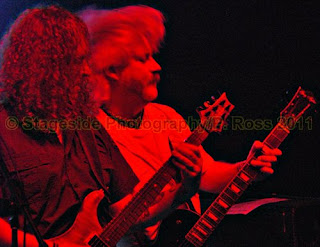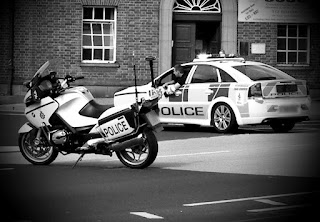Photograph by Stageside Photography (c) 2010
As a music tog I have been told by many of my peers that gig photography is one of the most difficult styles of photography to achieve perfection in your results.
And through practice I can tell you that they certainly aren't telling porky pies, not only do you have the lighting (or lack of in some cases) to contend with you also have figures constantly moving on stage and a lot of the time fans bouncing around you at the front or complaining that you are blocking their girlfriends view ( unfortunately for them I am six foot four) and sometimes beer or other liquids thrown around in your general direction.
Photograph by Stageside Photography (c) 2010
To work through these obstacles can take a lot of patience and a bit of pre-planning.
I like to arrive at a venue early this way I can scope the layout, often I like to get there for the sound and light check as this will tell me what kind of lighting I am up against for example LED's, Lasers or Strobes etc and often a chance to meet the band/s before the gig.
At this point you can also check out the stage where are the monitor speakers placed, the amps, the PA speakers?, mic stands etc which of the band members will be standing where, watch their sound check as this will usually reflect their stage performance.
Take a few practice shots whilst they are checking the lighting, DO NOT! I repeat, DO NOT! use flash many venues won't allow it and musicians dislike the use of flash as it can be off putting to their performance.
Remember you will be shooting in low light most of the time so set your camera accordingly, the settings I use for most venues with coloured LED lights are as follows:
Aperature: F5.6
ISO: 1600
Exposure around 1/8s
Turn white balance to florescent
These are not set in stone and it would pay off to experiment with each of the settings according to the venue you are in.
One of the most difficult parts of taking gig photographs is setting up your shots, often the performer is unpredictable... or so it seems to the novice, but beneath what may seem as an unprecedented urge for the singer to hang upside down from the stage scaffold, or the guitarist to wander off into the crowd or start playing his guitar backwards are usually moves stolen from other bands that came before them.
The classic Angus Young hop was devised by Chuck Berry twenty or thirty years before AC/DC for example, What I am about to suggest may seem unconnected to the world of photography but I believe that studying music videos and iconic music related photographs has helped me a great deal.
The Vocalist:
Photograph by Stageside Photography (c) 2010
Nearly always the vocalist is at the forefront of any band, usually the most flamboyant member of the band their confidence and ego can either glue a band together or drive them apart, take time to watch the band while you shoot them, the singers often show traits which they repeat this will help you determine when to take a shot for example: a singer may raise their hands and stretch out their neck for a high note, or lean into the camera the main job of the vocalist is to be seen and make sure they are seen, many times this person will be your main focus of attention.
The Rythm Guitarist:
Photograph by Stageside Photography (c) 2010
The Rythm Guitarist is usually the quietest of the group and not always a part of a group as you do get some bands who get by without one, they generally stay in one place on the stage and to me are technically the easiest member of the band to shoot they often have a rapport with the lead guitarist and they can often been seen mimicking each other or making jokes.
Photograph by Stageside Photography (c) 2010
The Lead Guitarist:
Photograph by Stageside Photography (c) 2010
The Lead Guitarist is very much like the vocalist as in they tend to move around the stage a lot, energetic, egotistical at times, they too want to hog the lime light and are often the major talent/songwriters in the band.
They have a rapport with the Vocalist more often than not which extends beyond the band, a brotherhood perhaps, again they are known to repeat moves by other guitarists watch for when they execute them and shoot.
The Drummer:
Photograph by Stageside Photography (c) 2010
Without a doubt the most difficult member of a band to capture uless you use a decent VR Zoom lens, as they are nearly always stuffed away at the back of the stage getting a decent shot of a drummer can be the biggest challenge, I try to shoot between the foreground members or from the side of the stage. The Drummer is probably the least photographed member of the band also.
The Bassist:
Photograph by Stageside Photography (c) 2010
Very much like the Rythm Guitarist, the Bassist is usually quite happy tucked away in a corner and is probably the easiest band member to capture in a shot as they don't move around as much (usually, there are exceptions).
By watching musicians perform as a photographer you can learn their traits, movements and habits even if I have seen a band for the first time, within the first two songs I can usually establish when a member of the band is going to do something shot worthy, however the best advice I was given was keep shooting no matter what, take a thousand photographs if you have to, experiment with angles and settings.
The other obstacles I mentioned such as fans and complaints can be worked around with a little professionalism and politeness, ask people if they would mind moving aside while you take your shot, apologise for getting in someones way but explain politely that you are there to do a job and that you will only be in that spot momentarily.
One other obstacle I forgot to mention was other photographers and cameramen/women at one of the venues I shot in regularly they have two sometimes three cameramen operating video cameras for a live feed to the internet, I work very well with one of these if he sees me about to take a shot he will wait till I have taken it before getting his shot and I will do the same for him, we have a mutual respect for one another in front of the stage we respect the fact that both are there to do a job and as such we need to work together.
There are also the odd one or two cameramen who won't care if they get in your shot in these circumstances I find it easier to just move to another spot and continue from there.
below are a few examples of my Gig photography.
 |
| K.o.kaine |
 |
| Little Vegas Lies |
 |
| Quadraphonia |




































